

30-Minute Lower Body Strength Workout (Trisets)
Build strong legs at home with this 30-minute lower body strength workout! Including squats, lunges and deadlifts — these six leg exercises target every muscle in the lower body. The “triset” format targets both the lower body push muscles and the lower body pull muscles.
This post is brought to you in partnership with the Minnesota Pork Board.
Build strength and challenge your push and pull lower body muscles with this 30-minute lower body strength workout.
This is another challenging workout we did with our friends at the Minnesota Pork Board. If you loved our 6 Single Leg Exercises and Strong Legs Workout, you’re going to love this one!
This leg strength workout is done in a triset format and includes my favorite lower body exercises with dumbbells. These are staple exercises that will effectively target the glutes, quads, calves, hamstrings, hips and thighs.

30-Minute Lower Body Strength Workout
Strengthen the legs at home with this lower body strength workout with dumbbells!
This triset workout focuses on the lower body push muscles (quads, glutes, calves) and the lower body pull muscles (glutes, hamstrings, hips).
Add lower body workouts like this one to your workout routine 1-2 times a week to build and maintain strength in the lower body.
Workout Equipment:
Medium to Heavy Set of Dumbbells.
I recommend between 10-25 lbs depending on your fitness level. I’m using 15 and 20 lb dumbbells in today’s workout.
Workout Instructions:
Follow along with the guided Lower Body Strength Workout on YouTube, led by certified personal trainer, Lindsey Bomgren.
Your Workout Looks Like This:
- 2 Trisets (3 leg exercises per triset circuit)
- Timed Intervals (40 seconds of work, 10 seconds rest; complete as many repetitions as you can in the timed interval)
- Repeat Each Triset x3 Sets

Prefer to Watch On YouTube?
Workout Outline
TRISET ONE:
- 2-Pulse Squat and 2 Calf Raises
- Pendulum Lunge
- Lateral Lunge
TRISET TWO:
- Deadlift
- Dumbbell Swings
- Frog Pump Glute Bridge
BONUS: Hinge Swing Squat Thruster
6 Lower Body Strength Exercises
2-Pulse Squat and 2 Calf Raises
Targets: Legs, glutes, quadriceps (thighs), hamstrings, calves and core.

How To Do A 2-Pulse Squat and 2 Calf Raises
- Start standing feet shoulder-width distance apart, knees slightly bent, core engaged. Hold a dumbbell vertically at your chest between both hands (goblet-hold).
- Lower down into a squat position, lowering your hips down parallel with your knees. Drive your knees out toward your outer three toes.
- At the bottom of your squat, pulse by rising up an inch, then lowering down an inch and repeating for a two-count pulse.
- Drive through your heels to stand tall, squeezing your glutes.
- As you stand, perform a calf raise by lifting your heels off the ground.
- Slowly lower your heels back to the ground, then repeat for a second calf raise.
Pendulum Lunge
Targets: Legs, butt, quads, hamstrings, calves and core.
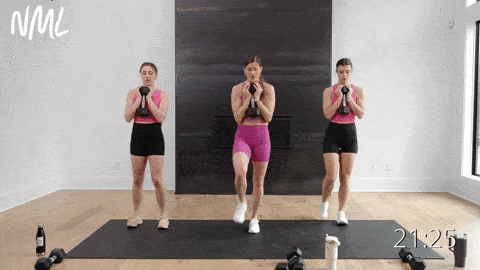
How To Do A Pendulum Lunge
- Start standing feet hip distance apart, knees slightly bent, core engaged. Hold a dumbbell vertically at your chest between both hands (goblet-hold).
- Step your left leg forward into a front lunge, dropping your back right knee down towards the ground as you lower your hips until both knees reach a 90-degree angle, front thigh is parallel to the floor.
- Drive through your front left heel to stand tall, reversing the movement.
- Rather than stopping at the top, immediately step your left leg back into a reverse lunge. Again, drop your back right knee down towards the ground as you lower your hips until both knees reach a 90-degree angle, front right thigh is parallel to the floor.
- Then drive through your front right heel to stand tall, reversing the movement again as you immediately repeat the front lunge.
Modification: Option to tap the toe of the moving leg at center between each front to back lunge movement. The tap will provide stability.
Lateral Lunge
Targets: Legs, quads, outer glutes (gluteus medius), inner thighs (adductors) and hips.
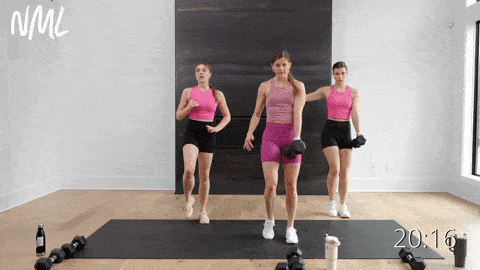
How To Do A Lateral Lunge
- Start standing, feet hip-width apart, knees slightly bent. Hold one dumbbell in your right hand.
- Step your left leg out to the side as you push your hips back, bending your left knee while leaving your right leg straight. Think of performing a single leg squat with your left leg while your right leg remains straight. The dumbbell in your right hand will fall just inside your left foot.
- Then, drive off your left foot to reverse the movement, pushing back to center and returning to a standing position. Option to perform a knee drive on the left leg as you return to center to increase the balance challenge. Alternate sides on the next set.
Modification: Option to omit the dumbbell, performing this with just your body weight.
Deadlift
Targets: The posterior chain or backside of the body. Specifically targeting the hamstrings, glutes, hips, calves, lower back and core.

How To Do A Romanian Deadlift
- Start standing feet shoulder-width apart and knees slightly bent. Hold a dumbbell in each hand at your thighs (overhand grip, palms face your body). Option to hold one heavy dumbbell horizontally with the heads of the dumbbell in each hand.
- Hinge forward at the hips, pushing your hips back as you lower the dumbbells down along the front of your body. You should feel a stretch in the back of your legs (hamstrings). Focus on keeping your back in neutral alignment with your neck and shoulders throughout the entire movement (straight line from head to tailbone). Keep a slight bend in your knees to avoid ‘locking out’ the joint.
- Then, drive through your heels, squeezing your glutes as you drive your hips forward to return to the starting position.
Dumbbell Swings
Targets: Glutes, hamstrings, hips, core, and all the stabilizing muscles in your back and shoulders.

How To Do Dumbbell Swings
- Stand with your feet wider than shoulder-width apart, holding a single dumbbell vertically between your hands.
- With a slight bend in your knees and weight in your heels, ‘hike’ the dumbbell back between your legs to start the swing movement.
- Drive through your heels to stand tall, pushing your hips forward as you squeeze your glutes to swing the dumbbell up. Aim for shoulder height, with arms extended out away from the body. Think long, loose arms (your arms are just a vehicle for moving the weight, your hips and glutes generate the power).
- As the dumbbell begins to descend, think of catching the weight with a hip hinge, loading the glutes and hamstrings.
Frog Pump Glute Bridge
Targets: Gluteus maximus (large glute muscles), gluteus medius (side butt muscles or outer glute muscles), and gluteus minimus (hip extension).

How To Do Frog Pump Glute Bridges
- Lie flat on your back and bend your knees, making a 90-degree angle with your legs, feet on the mat. Place one heavy dumbbell horizontally across your hips.
- Press the soles of your feet together and let your thighs fall open. Externally rotating the hips (heels together and knees out).
- Squeeze the glutes to lift the hips off the mat. Think of performing a shallow hip thrust.
- Hold at the top of the movement for a moment, tucking the pelvis under. Then slowly lower your hips with control back down to a hover position (glutes hovering off the mat) and repeat the movement.
Modification: Option to omit the dumbbell, performing this as a bodyweight exercise. You can also omit the external hip rotation and perform standard glute bridges with feet flat on the floor.
Lower Body Strength Workout FAQs
The best way to grow muscle in the lower body is through a combination of “complete” leg day workouts targeting all of the major muscle groups and isolation (muscle-group specific) leg workouts, like thigh workouts or glute workouts. Keep in mind that in order to build muscle, you need to implement progressive overload (increase the intensity of your workouts over the course of weeks or months). Either increase reps or increase the weights you’re using to build strength.
Squats, lunges and deadlifts are some of the most effective exercises to strengthen the legs at home (Mayo Clinic). These compound exercises focus on building the glutes (butt), hamstrings (back of the legs), quads (top of the thighs), hips (hip flexors), adductors (inner thighs) and abductors (outer glutes).
More Workouts
Strength WorkoutsPin This Workout:
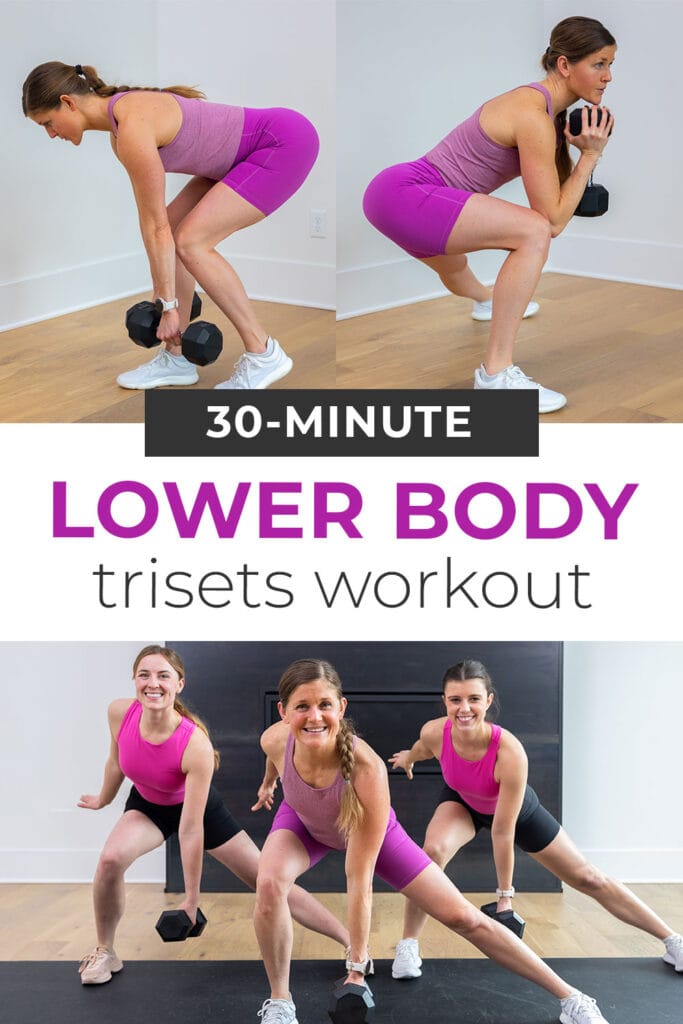
This post includes affiliate links. I do earn a commission for products purchased using these links (at no additional cost to you). Thank you for supporting Nourish Move Love, making the content you see on this blog possible.










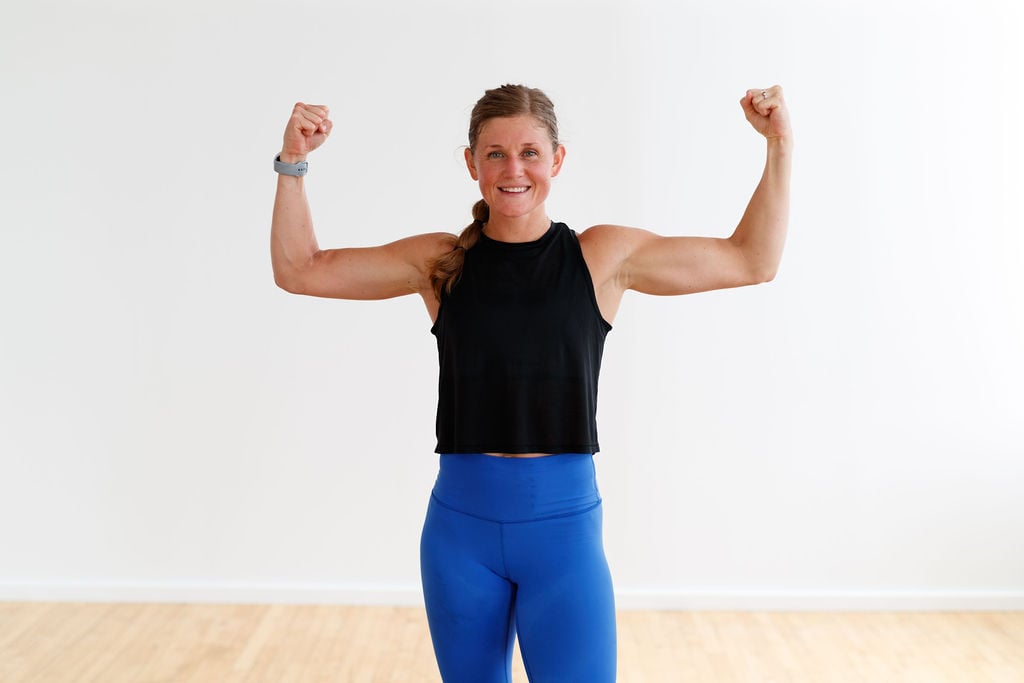









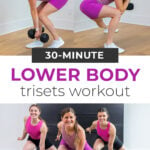


Great workout! The format was excellent. Love your wealth of knowledge in fitness. In another video can you share why muscle soreness is not the goal. Fantastic work ladies!
Jazmin! So glad you enjoyed this workout – nice work! Feeling sore is an indicator of tiny microscopic tears in the muscle resulting in inflammation, often referred to as DOMS (delayed-onset muscle soreness). Muscle damage and DOMS may play a small part in muscle growth, but they by no means should be used as a primary gauge of growth following a workout. Keep up the great work!! -Lindsey